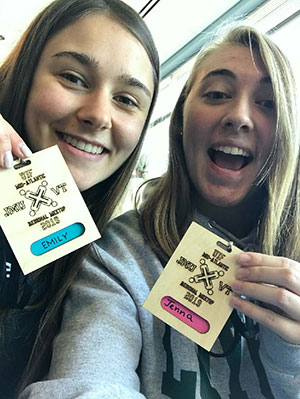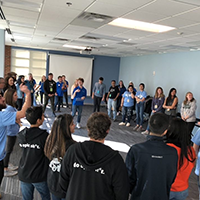Loyola’s University Innovation Fellows Attend Regional Meetup
The first weekend of November, two of Loyola University Maryland’s University Innovation Fellows (UIFs), Emily Cebulski (2018 cohort) and Jenna Bower (2019 cohort), attended a regional meetup at James Madison University in Virginia. They returned to campus energized with fresh ideas for continuing to build a culture of innovation at Loyola. Read more about Emily and Jenna’s experience in their full report below.
Inside the Mid-Atlantic Regional UIF Meetup Hosted by JMU and VT
By: Emily Cebulski and Jenna Bower
 Friday 11/1
Friday 11/1
After checking into our AirBnB and grabbing a quick bite to eat, we headed to the X Lab Emily and Jenna, two of Loyola University Maryland's UIFs located in James Madison’s Lakeview Hall. We were greeted by the JMU fellows and received some pretty epic swag for the weekend ahead. Once settled in, we got to work in the X Lab, creating costumes and prototyping with materials in the lab. The X Lab is a collaborative space for all JMU students to utilize. It is full of various types of prototyping materials including pipe cleaners, markers, post-it’s as well as more technical equipment like drills, saws, and sanders. The space overall resembles a garage with a large door that can be opened to accommodate large projects. Our prototyping was inspired by a local folk artist which created a relaxing and accepting vibe that encouraged creative thinking and taking risks. We wrapped up the night by eating ice cream with the fellows and getting to know everyone a little bit better.

Saturday 11/2
Morning
We arrived at Lakeview Hall once again to be welcomed by the University President and get the day formally started. More fellows from Virginia Tech and the University of South Carolina arrived for the rest of the meetup. A campus club called the Outriggers came by to lead some fun team building activities that increased the comfort level across the group and energized us for the busy day ahead. This was followed by a design thinking workshop led by some of the VT fellows. We worked with other fellows to identify and collaborate to solve various issues that all University students face, including healthy food access, time management, identifying intersectionality and relevance between various courses. After this workshop we participated in an inspiration walk that allowed us to pay attention to the importance of perspective when tackling issues that we face.



Afternoon
We headed downtown for lunch at Beyond, an Asian fusion restaurant. Continuing our tour of Harrisonburg, we ventured to three different companies to get a glimpse of how they use technology and innovation to be leading change agents in the community. First, we went to Generate Impact where we heard from the founder and Director of Innovation, Chiedo John. Chiedo spoke about his journey of launching a startup while still in his undergraduate studies, and the various peaks and valleys that come with the design and iterative process in the generation of products being pushed to the consumer market. Next, we visited Jenzabar, a company of about 450 employees that specializes in launching technological products for higher education institutions to optimize housing, scheduling, and grade reporting. Each floor of Jenzabar’s workspace was lined with whiteboards and collaborative meeting rooms for project teams to work together on their educational products. Jenzabar’s workspace aligned with its goals to empower its employees to effect change at all levels, whether that is through interns or senior managers. We wrapped up our tour at the courthouse where we met with the Clerk of the Circuit Court, Chaz Haywood. His work is centered around the preservation of history in Harrisonburg through the restoration and digitization of many records so that they are easily accessible to the public. It was inspiring to see the innovative work of an individual that isn’t completely submerged in engineering or coding; innovation is integral to every discipline’s success. He also gave us some cute gavel pencils to take as a souvenir. :)
Evening
After eating dinner back at the X Lab, we listened to a talk about the importance of incorporating design thinking and innovation as a means to progressing within a career from guest speaker, Andras Szakal, an executive at IBM. We wrapped up our night with an activity called “If tomorrow” that focused on building psychological security between groups by asking questions of various levels of depth to encourage others to open up and be vulnerable amongst the group. This exercise emphasized the importance of trust and openness in the bonding of teams of people that may be collaborating on a common goal. Our night ended in “The Tank” where we bonded with other fellows by playing video games and Heads Up. In this space, all of the tabletops were whiteboards, and the TVs on the walls folded down to be tablet surfaces where students could digitize their ideas. This creative space could be used for all types of groups, whether pop-up classes, club meetings, or general hangouts.

Sunday 11/3
Morning
The day began with a nine-person alumni panel that spoke to their experiences in pursuing their passions despite obstacles and setbacks, as well as giving advice to students who may not be sure exactly what they’re interested in yet. These alumni were all connected with the UIF program in some way, whether fellows, program coordinators, or faculty champions.
Afternoon
Following lunch, we listened to a talk from Faculty Champion Leigh Lally of Virginia Tech about being future shapers in using the design thinking strategies and entrepreneurial mindsets we all have developed. This talk culminated in an activity that encouraged us to consider seemingly impossible ideas we’d like to see happen, and then looking at their primary and secondary consequences, both positive and negative. It was interesting to see that even the most well-intended ideas had some negative consequences. The meetup closed out with a tour of JMU’s campus where we were able to get a glimpse of other innovative spaces on campus outside of the X Lab. We walked through the Student Success Center as well as a couple of the Industrial Design buildings to view the spaces within them that encourage creativity and collaboration among students, these spaces including galleries and student run spaces that offer the opportunity to show off work. Overall, it was incredible to see the hands-on work that students are able to engage in through their majors at JMU. Overall, our main takeaway from the trip included the importance of equipping students who may not be directly involved with UIF or innovation on campus with innovative and collaborative spaces that encourage creativity and design thinking amongst their projects and passions. It was interesting to see how a much larger institution such as JMU approaches the implementation of an innovative environment, and how despite the size difference of our universities the places in need of innovation amongst higher education are the same. This fosters an inherent connection amongst all changemakers, that spans beyond the walls of university settings, and into the passion-filled endeavors that fuel our desire to share what we have learned through the UIF program with others.
We would like to thank Loyola for sponsoring our participation in this incredible program and the fellows at James Madison University and Virginia Tech for planning, hosting, and welcoming us into their collaborative space. We look forward to working with them in the future to use our shared knowledge to make our universities the best that they can be.
 Taking What We’ve Learned Back to Loyola
Taking What We’ve Learned Back to Loyola
As we toured many of the spaces on JMU’s campus, it occurred to us that the success of an innovative environment relies on the presence of collaborative spaces with materials for students to truly engage their creative minds. Many of JMU’s study spaces and meeting rooms were filled with furniture that could easily be moved around the space to change its layout or general purpose. For example, much of the conference was contained in one room, which was organized in many different configurations to accommodate a panel of speakers, dinner, an epic dance party, and a traditional lecture hall. This, when combined with surfaces that students can write on, and add sticky notes to, is essential for promoting collaborative thinking and innovation ideation within the space.